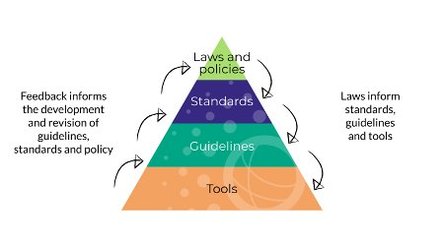
Do you sometimes feel confused about different kinds of guidance on the same topic and wonder which one you should follow? I would like to offer a way of navigating through different kinds of guidance using one example to illustrate: the guidance around including persons with disabilities.
We’ve come a long way in making persons with disabilities and their right to participation and access aid more visible in humanitarian work. Two standards handbooks explicitly address the rights of persons with disabilities in humanitarian aid: the Sphere standards and the Humanitarian inclusion standards for older people and people with disabilities. With the recently published Inter-Agency Standing Committee (IASC) disability guidelines, you may wonder how these are different.
Put simply, there is a logical sequence from the codification of rights to their implementation:
International laws, conventions and policy frameworks define and specify rights and responsibilities (you can find a list of legal foundations to the Sphere standards online). One example is the Universal Declaration of Human Rights of 1948.
Humanitarian standards outline what needs to be done in humanitarian settings to achieve the rights and responsibilities specified in international laws, conventions, and policies. One example is the Sphere Handbook.
Guidelines offer detailed guidance on how to implement actions based on standards and laws. They take account of operational and organisational contexts. Examples are the EU Civil Protection Guidelines.
Based on standards and guidelines, specific tools may be developed to support implementation.
The following illustrates the relationship among laws and policies, standards, guidelines, and tools.
Going back to the example of disability guidance, these various levels are explained below:
Laws, conventions, and policy frameworks
The Convention on the Rights of Persons with Disabilities (2006) supports the rights of persons with disabilities under all other human rights treaties. It also focuses on awareness-raising and non-discrimination and covers “situations of risk and humanitarian emergencies”. This legal framework can be further strengthened through policy frameworks, which express political commitment. Explicit commitments to inclusive humanitarian action are included in the Sendai Framework for Disaster Risk Reduction (2015) and the Charter of Inclusion of Persons with Disabilities in Humanitarian Action (2016).
Standards
The Sphere standards include a focus on the inclusion of persons with disabilities from the outset and advocate for data disaggregated by sex, age, and disability. With each revision of the standards, the theme has been better embedded in technical guidance. The Humanitarian inclusion standards for older people and people with disabilities focus on including disability throughout humanitarian programmes based on the Core Humanitarian Standard (CHS) commitments and on a few key technical sectors – those covered by Sphere, plus education.
Guidelines
Global standards are better implemented when translated into organisational, project, or response guidance. The IASC Guidelines on Inclusion of Persons with Disabilities in Humanitarian Action build on the Sphere standards (including the CHS) and the humanitarian inclusion standards. The guidelines were drafted in full consultation with persons with disabilities and support effective planning and delivery of humanitarian action which is inclusive across all intervention phases and sectors.
With the link between the IASC guidelines and existing humanitarian standards established, it may be easier to choose which document to use. There may be times when the guidelines provide the right level of detail and direction, and others when standards will be the right framework to use – and you can use the standards and guidelines in parallel. If you need more sector tools and resources, the IASC guidelines will provide a list of these. One of the most used tools for collecting data disaggregated by disability status is the Washington Group questions.
There is a parallel to this logical sequence in national laws where governments are obliged to translate international legal frameworks and standards into national laws and standards (e.g. national law on persons with disabilities and accessibility standards), and national guidelines and tools support implementation and adherence to these standards (e.g. national guidelines for inclusive education and national census and service registers with disability data questions sets).
To conclude, I would argue that the issue may not be too much guidance, but that guidance developers and users need to be clear about the laws, policies, and standards a guidance document is built on and promotes. It seems to me that the more closely you build guidance on existing standards and policies, the more you will avoid confusion and support a coherent and user-friendly approach to humanitarian response. And lastly, it remains important that organisations support their staff by ensuring that their own guidance reflects the standards and guidelines they adhere to, so that their staff knows what to follow and don’t need to make the choice themselves.
Written by Aninia Nadig, Sphere’s Policy and Pratice Manager
This piece was originally published on Sphere.org